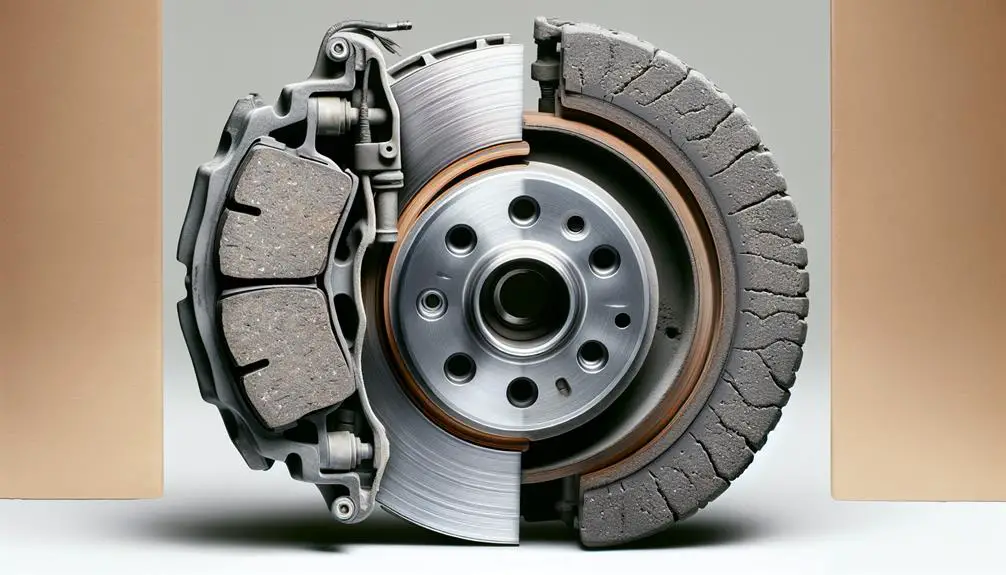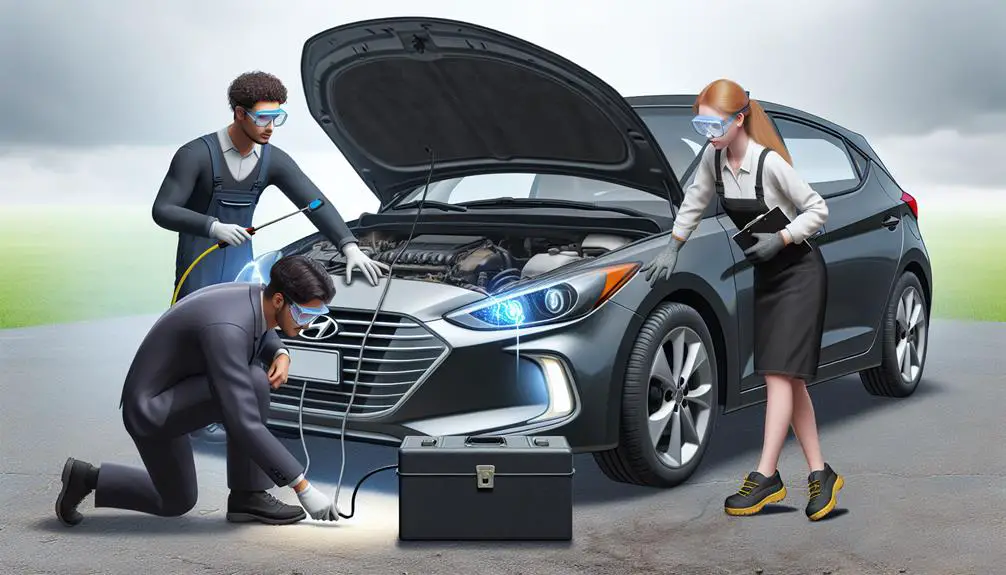Replacing Hyundai Elantra brake pads involves several steps:
- Safety first: Lift the car using a jack and secure it with jack stands to create a safe working environment.
- Remove the wheel: Loosen the lug nuts, lift the wheel off, and set it aside in a safe place.
- Replace the brake pads: Locate the brake caliper, remove the old brake pads, and install the new ones in the brake assembly.
Identifying Worn Brake Pads

Listening for a high-pitched squeal while braking can signal it's time to check your Hyundai Elantra's brake pads for wear. This sound is a telltale sign that the pads have thinned out and are reaching their end of life. But don't just rely on your ears! It's important to visually inspect the pads for a more accurate assessment.
When you take a look, you're aiming to find pads that have less than 1/4 inch of material left. Anything less and it's definitely time for a replacement. Remember, the brake pads are vital for creating the friction that slows down your car, so don't take chances with worn-out pads.
You might notice uneven wear on the pads. This can be a sign of other issues with the brake system, but it still means the pads need to go. Uneven wear often points to sticking caliper pistons or problems with the brake hardware, so keep an eye out for these symptoms.
Another sign of wear is deep grooves or scoring on the brake pad surface. If you see these, it means the pads have been grinding against the rotors, potentially damaging them as well. This kind of wear can greatly impact your braking performance and safety.
Important, if your Hyundai Elantra pulls to one side when braking, it could mean one set of brake pads is wearing down faster than the other. This uneven braking can cause your car to handle unpredictably, especially in emergency braking situations. Always address any signs of wear immediately to guarantee your safety on the road.
Gathering Necessary Tools
What tools do you need to successfully replace the brake pads on your Hyundai Elantra?
First things first, you'll need a car jack and jack stands to safely lift and support your vehicle. Don't rely solely on the car jack for safety; jack stands are essential for ensuring the car stays securely elevated while you work.
Next, grab a lug wrench. You'll use this to initially loosen the lug nuts. Although we're not delving into removing the wheel here, it's important to know that loosening them while the car is on the ground makes the process easier.
You'll also need a socket set. The most common sizes for Hyundai Elantras are 14mm and 17mm sockets, but it's wise to have a range on hand. These sockets will be used to remove the caliper bolts.
Don't forget a C-clamp or a brake caliper tool. This is essential for compressing the brake caliper piston back into its housing, making room for your new brake pads.
A torque wrench is another must-have. This ensures that you re-tighten the caliper bolts to the manufacturer's specified torque setting, which is essential for your safety.
Lastly, consider having some brake cleaner, a wire brush, and an old rag at your disposal. These will help you clean the caliper and surrounding area before installing new pads, ensuring a smoother and more reliable brake pad replacement.
Gathering these tools before you start ensures that the brake pad replacement process goes smoothly, keeping you safe and saving time.
Removing the Wheel

Now that you've gathered all the necessary tools, it's time to remove the wheel from your Hyundai Elantra. This step is important before you can get to the brake pads. It might seem intimidating if you've never done it before, but with a few simple steps, you'll have that wheel off in no time. Let's break it down.
- Park on a Level Surface and Loosen the Lug Nuts: Before you jack up your Elantra, make sure it's parked on a flat surface. Then, using your lug wrench, slightly loosen the lug nuts on the wheel you're working on. Don't remove them completely just yet; just break the initial resistance.
- Jack Up Your Car: Depending on where you're working on your car, you'll want to place the jack under the vehicle at the recommended lift points. These are usually indicated in your car's manual. Pump the jack handle until the wheel is off the ground, giving you enough clearance to work comfortably.
- Remove the Lug Nuts and Wheel: Now that your car is securely jacked up, it's time to remove the lug nuts you previously loosened. Keep them in a safe place—you'll need them to secure the wheel back on. With the lug nuts removed, the wheel should come off easily. If it doesn't, give it a gentle tap from behind or wiggle it slightly to loosen it.
- Set the Wheel Aside: Place the removed wheel in a safe location where it won't roll away or obstruct your working area.
And just like that, you're ready to move on to the next step. Remember, safety ensure—ensure your car is securely lifted before you start working on it.
Replacing the Brake Pads
With the wheel successfully removed, it's time to focus on replacing the brake pads on your Hyundai Elantra.
Initially, you'll need to locate the brake caliper. It's the component that houses the brake pads and presses them against the rotor to slow your car. Use a wrench to loosen and remove the bolts securing the caliper. Be cautious; the caliper will still be connected to the brake line, so don't attempt to completely detach it. Instead, gently slide the caliper off the rotor and support it with a wire or a bungee cord to avoid strain on the brake hose.
Next, you'll see the old brake pads inside the caliper bracket. Observe how they're positioned; taking a photo can be helpful for reference. Remove the old pads, noting any clips or shims that might need to be transferred to the new pads. If your Elantra's brake pads came with new hardware, it's a good idea to replace these components as well.
Before installing the new brake pads, check the rotor for signs of wear or damage. If the rotor is severely worn or damaged, it may need to be replaced or resurfaced. Assuming the rotor is in good condition, you can proceed to install the new pads. Place them into the caliper bracket, ensuring they're properly seated and aligned. If your model requires, reinstall any clips or shims.
Testing Your New Brakes

After replacing your Hyundai Elantra's brake pads, it's vital to test your new brakes to make sure they're functioning correctly. Proper testing guarantees that your brake system is safe and responsive, preventing any potential issues while driving. Here's how to test your new brakes effectively:
- Start Slowly
Begin by driving your Elantra at a low speed in an area without traffic, such as an empty parking lot. Gently apply the brakes several times at slow speeds. This process helps the new brake pads to settle in properly.
- Listen for Noise
Pay close attention to any unusual noises. Squeaking or grinding sounds can indicate that the brake pads aren't installed correctly or there might be an issue with the brake rotors. No noise is a good sign that your brakes are functioning as they should.
- Perform a Brake Test at Higher Speeds
Once you're confident that the brakes are working correctly at low speeds, gradually increase your speed and test the brakes again. It's essential to confirm that your car stops smoothly and promptly without pulling to one side.
- Check the Brake Pedal Feel
Lastly, pay attention to how the brake pedal feels when you apply pressure. It should feel firm, not spongy or overly hard. A firm pedal indicates that the brake system is properly pressurized and the brake pads are correctly seated.
Testing your new brakes guarantees that your Hyundai Elantra is safe to drive. If you notice any issues during these tests, it's vital to address them immediately to maintain your vehicle's safety.
Conclusion
You've successfully swapped out your Hyundai Elantra's brake pads, taking a critical step towards ensuring your car's safety. Remember, regularly checking and replacing worn pads is key.
With the right tools and a bit of patience, you've tackled this task smoothly. Now that you've tested your new brakes, you can drive with confidence, knowing your vehicle is in top shape.
Keep up the good work, and your Elantra will thank you with reliable performance on the road.